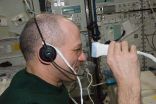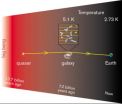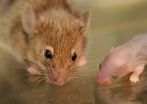HOUSTON, TX, January 24, 2013 (Press-News.org) What an inspired idea -- let students teach and share with others the interesting research astronauts do on the International Space Station, or ISS. After all, today's students are the future explorers and innovators of scientific discovery, space exploration, and technological innovation. There is often nothing more gratifying to a kid or young adult than sharing what they know with others -- particularly their parents, teachers or friends.
While the orbiting lab is breaking ground on scientific and technological exploration fronts, time is made for educational endeavors, too -- events and projects that encompass many different topics.
The International Space Station Science Challenge is an excellent opportunity for students to learn more about the different types of investigations performed on orbit. At the same time they can hone their scientific analysis skills and share what they learned with others.
"The most interesting thing we learned is how to work as a team and how to use each other's ideas together," said Andrea and Carlie, sixth grade student teammates who studied butterflies and spiders.
Pilot 1 winners were announced Jan. 18. Pilot 2 kicks off in February. While the pilot teams include a small sampling of schools, the goal is to extend the program to students nationwide by the 2013-2014 school year.
Here's how the challenge works -- students in grades 5-12 review the extensive list of investigations that have either been completed or are currently being conducted on the station, choosing one that interests them most. Their challenge is to develop a project that teaches others about their chosen experiment -- creating a Web page, PowerPoint presentation, podcast or video podcast, or written report that is informative and interesting.
Each project answers questions about the principal investigator(s), the goal of the selected investigation and the mission(s) it flew on, along with procedures or steps, results obtained, and the benefits to Earth and space research identified.
Students use NASA's Space Station Research and Technology website for researching investigations. The descriptions provided on the site align with the National Science Education Standards for Physical Science, Life Science, Science and Technology, and Science in Personal and Social Perspectives.
Abishek, one of the students who submitted two challenges, said, "I never knew NASA did so many different tests and experiments. I mean I know you guys did a lot but the sheer number of experiments posted on the site still amazed me!"
Participants submit projects for judging with a brief narrative of why they chose a particular investigation and what they learned. Projects are featured on the challenge website, with winning submissions highlighted on the NASA Education website.
The Pilot 1 winners chose exciting investigations to highlight in the areas of Earth and space science, biology and biotechnology, human research, physical science and technology. Investigations students chose to learn more about included cell culturing, diagnostic ultrasound, robotics, treadmill kinematics, soldering in microgravity, Earth observations, combustion, and possible exercise countermeasures for bone and muscle loss.
Sixth grade students interviewed had many thoughts on the project: One thought it was interesting that astronauts could sleep in any direction they wanted because of microgravity, while another was amazed by the number of computers they have on the space station to do research.
"It was cool to learn that things might react differently in space. Astronauts do experiments in space so they can learn new things and improve things on Earth and also to learn more so people can eventually live other places in space," said another sixth grader.
This project is the brainchild of teachers Darcie Fregoe and Lisa Chizek, and piloted in their classrooms; both are contributing teachers from NASA's Endeavour Science Teaching Certificate Project. High school students participated in the pilot project as part of the Interdisciplinary National Science Project Incorporating Research and Education Experience, also known as INSPIRE.
"I believe it is my responsibility as a middle school Earth Science/Astronomy teacher to educate students about the very valuable contributions ISS Science has made on their lives," said Fregoe. "I want them to get excited about NASA and the ISS, and I want them to start thinking about possible futures working for NASA."
"Seeing the excitement as the students collaborated and turned their understanding into projects to teach others was very inspiring," Chizek said.
The International Space Station Science Challenge program is a collaboration between Teaching From Space, ISS National Lab, ISS Program Science Office and INSPIRE. For more information on student programs visit the NASA Science for Researchers Student Programs website.
"The ISS Science Challenge gives students the opportunity to learn about the research happening on the ISS in depth. It develops the creative, cognitive, and presentation skills of students while producing useful material for their peers and the public to understand the work of ISS research," said Dynae Fullwood, Teaching From Space education specialist.
"I always have my students go home and teach their parents what they are learning in my class," Fregoe said. "Several parents sent in very positive notes that they too didn't know much about NASA and the ISS and were enjoying learning from their children."
You can read more about these investigations, and others, on the space station latest news page:
http://www.nasa.gov/mission_pages/station/research/news.html
For more information on past, ongoing, and future ISS research activities, including research results and publications, please visit:
http://www.nasa.gov/mission_pages/station/research/index.html
If you are interested in subscribing to updates from the ISS Program Science Office, please visit:
https://lists.nasa.gov/mailman/listinfo/iss-program-science-group
For more information about the International Space Station, visit:
http://www.nasa.gov/station
For information about NASA and agency programs, visit:
http://www.nasa.gov
Students Teach the World About Space Station Science
RELEASE: JR13-006
2013-01-24
ELSE PRESS RELEASES FROM THIS DATE:
Hall of Fame Coach Mike Ditka to Host Charity Fundraising Event During Super Bowl Week in New Orleans
2013-01-24
Hall of Fame coach Mike Ditka will be hosting a charity fundraising event to benefit Gridiron Greats Assistance Fund and The Kevin Turner Foundation on February 1, 2013 from 7pm to 10pm at The Foundry (333 Saint Joseph Street) in New Orleans, LA, as part of the Super Bowl week festivities. The event entitled, An Exclusive Evening With Ditka and Friends, will allow attendees to spend time with Coach Ditka and some of his NFL friends, hear their stories, and contribute to a worthy cause. The evening will also feature a special live music performance from The Kyle Turley Band, ...
Prediction of Asian summer monsoon rainfall and tropical storm activity close at hand
2013-01-23
The amount of rainfall and number of tropical storms during the summer monsoon season greatly impact the agriculture, economy, and people in Asia. Though meteorologists and climate scientists have worked for years to develop helpful prediction systems, seasonal predictions of these two types of weather phenomena are still poor. Scientists working at the International Pacific Research Center, University of Hawaii at Manoa, have now made a promising breakthrough for predicting in spring both the summer monsoon rainfall over East Asia and the number of tropical storms affecting ...
Residents near Chinese e-waste site face greater cancer risk
2013-01-23
CORVALLIS, Ore. – Residents living near an e-waste recycling site in China face elevated risks of lung cancer, according to a recent study co-authored by Oregon State University researchers.
Electronic trash, such as cell phones, computers and TVs, is often collected in dumps in developing countries and crudely incinerated to recover precious metals, including silver, gold, palladium and copper. The process is often primitive, releasing fumes with a range of toxic substances, including polycyclic aromatic hydrocarbons, or PAHs, a group of more than 100 chemicals.
PAHs, ...
Plants adapt to drought but limits are looming, study finds
2013-01-23
Scientists with the U.S. Department of Agriculture, or USDA, and their partners have determined that water demand by many plant communities can fluctuate in response to water availability, indicating a capacity for resilience even when changing climate patterns produce periodic droughts or floods.
But their research also suggests that a limit to this resilience ultimately could threaten the survival of these plant communities. Sensitive environments such as the arid grasslands in the Southwestern U.S. already are approaching this limit.
Results from this study were published ...
Immune cell death defects linked to autoimmune diseases
2013-01-23
Melbourne researchers have discovered that the death of immune system cells is an important safeguard against the development of diseases such as type 1 diabetes, rheumatoid arthritis and lupus, which occur when the immune system attacks the body's own tissues.
The finding suggests that these so-called autoimmune diseases could be treated with existing medications that force long-lived immune system cells to die.
In the development of the immune system, some cells are produced that have the potential to attack the body's own tissues, causing autoimmune disease. The death ...
CSIRO telescope takes temperature of Universe
2013-01-23
Astronomers using a CSIRO radio telescope have taken the Universe's temperature, and have found that it has cooled down just the way the Big Bang theory predicts.
Using the CSIRO Australia Telescope Compact Array near Narrabri, NSW, an international team from Sweden, France, Germany and Australia has measured how warm the Universe was when it was half its current age.
"This is the most precise measurement ever made of how the Universe has cooled down during its 13.77 billion year history," said Dr Robert Braun, Chief Scientist at CSIRO Astronomy and Space Science.
Because ...
Studies provide insights into inherited causes of autism
2013-01-23
The most consistent finding of autism research lies in the revelation that the disorders are incredibly complex. Two new studies in the January 23 issue of the Cell Press journal Neuron that add to the growing appreciation of this complexity focus on identifying inherited genetic mutations linked with autism spectrum disorders. The mutations—which are distinct from the spontaneous mutations that have been the focus of previous studies—may provide valuable insights into the causes of autism.
"It's long been known that autism is a heritable condition and that some cases ...
New brain circuit sheds light on development of voluntary movements
2013-01-23
DURHAM, N.C. – All parents know the infant milestones: turning over, learning to crawl, standing, and taking that first unassisted step. Achieving each accomplishment presumably requires the formation of new connections among subsets of the billions of nerve cells in the infant's brain. But how, when and where those connections form has been a mystery.
Now researchers at Duke Medicine have begun to find answers. In a study reported Jan. 23, 2013, in the scientific journal Neuron, the research team describes the entire network of brain cells that are connected to specific ...
Whole-exome sequencing identifies inherited mutations in autism
2013-01-23
Boston, Mass. - While autism clearly runs in some families, few inherited genetic causes have been found. A major reason is that these causes are so varied that it's hard to find enough people with a given mutation to establish a clear pattern. Researchers at Boston Children's Hospital have pinpointed several inherited mutations—among the first to be identified—through an unusual approach: using whole-exome sequencing to study large Middle Eastern families with autism.
The study, published in the January 23 issue of the journal Neuron, also found evidence for some of ...
Setting the dark on fire
2013-01-23
In space, dense clouds of cosmic gas and dust are the birthplaces of new stars. In visible light, this dust is dark and obscuring, hiding the stars behind it. So much so that, when astronomer William Herschel observed one such cloud in the constellation of Scorpius in 1774, he thought it was a region empty of stars and is said to have exclaimed, "Truly there is a hole in the sky here!" [1]
In order to better understand star formation, astronomers need telescopes that can observe at longer wavelengths, such as the submillimetre range, in which the dark dust grains shine ...
LAST 30 PRESS RELEASES:
What causes some people’s gut microbes to produce high alcohol levels?
Global study reveals widespread burning of plastic for heating and cooking
MIT study shows pills that communicate from the stomach could improve medication adherence
Searching for the centromere: diversity in pathways key for cell division
Behind nature’s blueprints
Researchers search for why some people’s gut microbes produce high alcohol levels
Researchers find promising new way to boost the immune response to cancer
Coffee as a staining agent substitute in electron microscopy
Revealing the diversity of olfactory receptors in hagfish and its implications for early vertebrate evolution
Development of an ultrasonic sensor capable of cuffless, non-invasive blood pressure measurement
Longer treatment with medications for opioid use disorder is associated with greater probability of survival
Strategy over morality can help conservation campaigns reduce ivory demand, research shows
Rising temperatures reshape microbial carbon cycling during animal carcass decomposition in water
Achieving ultra-low-power explosive jumps via locust bio-hybrid muscle actuators
Plant-derived phenolic acids revive the power of tetracycline against drug-resistant bacteria
Cooperation: A costly affair in bacterial social behaviour?
Viruses in wastewater: Silent drivers of pollution removal and antibiotic resistance
Sub-iethal water disinfection may accelerate the spread of antibiotic resistance
Three in four new Australian moms struggle with body image
Post-stroke injection protects the brain in preclinical study
Cardiovascular risk score predicts multiple eye diseases
Health: estimated one in ten British adults used or interested in GLP-1 medications for weight loss
Exercise to treat depression yields similar results to therapy
Whooping cough vaccination for pregnant women strengthens babies’ immune system
Dramatic decline in new cases of orphanhood in Uganda driven by HIV treatment and prevention programs
Stopping weight loss drugs linked to weight regain and reversal of heart health markers
Higher intake of food preservatives linked to increased cancer risk
Mass General Brigham–developed cholera vaccine completes phase 1 trial
First experimental validation of a “150-year-old chemical common sense” direct visualization of the molecular structural changes in the ultrafast anthracene [4+4] photocycloaddition reaction
Lack of support for people on weight loss drugs leaves them vulnerable to nutritional deficiencies, say experts
[Press-News.org] Students Teach the World About Space Station ScienceRELEASE: JR13-006







